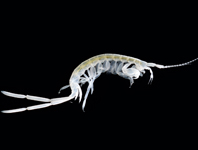Abstract
Eriopisidae is a widespread amphipod family, whose members have subcylindrical bodies, often do not have eyes, showing elongate third uropods in which the endopod is reduced and the exopod can become very long. This is the first record of Eriopisidae from Central America. Here, we describe the new genus and species Panamapisa guaymii gen. nov., sp. nov. from Bocas del Toro, Panama. The taxon differs from other members of the family in having a greatly enlarged merus on gnathopod 1, marginal setae on the dactyls of pereopod 5 to 7 and a third uropod nearly as long as the body.
References
Ariyana, H. (2015) Three new species of the Eriopisa group (Crustacea: Amphipoda: Eriopisidae) from Japan, with the description of a new genus. Zootaxa, 3949 (1), 91–110.
https://doi.org/10.11646/zootaxa.3949.1.4
Barnard, J.L. & Karaman, G.S. (1982) Classificatory revisions in gammaridean Amphipoda Crustacea), Part 2. Proceedings of the Biological Society of Washington, 95, 167–187, fig. 1.
Bousfield, E.L. (1983) An updated phyletic classification and palaeohistory of the Amphipoda. In: Schram, F.R. (Ed.), Crustacean Phylogeny. Museum of Natural History, San Diego, pp. 257–277, 2 figs.
Garm, A. & Watling, L. (2013) The crustacean integument: setae, setules, and other ornamentation. In: Watling, T. & Thiel, M. (Eds.), The Natural History of the Crustacea. Functional Morphology and Diversity. Oxford University Press, Oxford, pp. 167–198.
https://doi.org/10.1093/acprof:osobl/9780195398038.003.0006
Karaman, S.L. (1943) Die unterirdischen Amphipoden Südserbiens. Srpska Akademya Nauka, Posebna Izdana, 135 (Prirodn’achki i Mathematichki Spici), 34 (4), 161–312.
Karaman, G.S. (1982) Gammaridae. In: Ruffo, S. (Ed.), The Amphipoda of the Mediterranean, Part 1, Gammaridea (Acanthonotozomatidae to Gammaridae). Memoires de l’Institut Oceanographique, 13, pp. 245–364, figs. 166–243.
Karaman, G.S. (1984a) Revision of Eriopisa-complex of genera (Gammaridae). Poljoprivreda i Sumarstvo, Titograd, 30, 39–72, 4 figs.
Karaman, G.S. (1984b) Contribution to the knowledge of the Amphipoda. 141. Quadrus vagabundus, new genus and species, and revision of genus Eriopisella Chevreux (Gammaridea). Studia Marina, 15–16, 131–148.
Karaman, G.S. & Barnard, J.L. (1979) Classificatory revisions in gammaridean Amphipoda (Crustacea), Part 1. Proceedings of the Biological Society of Washington, 92 (1), 106–163.
Lowry, J.K. & Fenwick, G.D. (1983) The shallow-water garnrnaridean Arnphipoda of the subantarctic islands of New Zealand and Australia: Melitidae, Hadziidae. Journal of the Royal Society of New Zealand, 13 (4), 201–260.
https://doi.org/10.1080/03036758.1983.10420802
Lowry, J.K. & Myers, A.A. (2013) A Phylogeny and Classification of the Senticaudata subord. nov. (Crustacea: Amphipoda). Zootaxa, 3610 (1), 1–80.
https://doi.org/10.11646/zootaxa.3610.1.1
Lowry, J.K. & Springthorpe, R.T. (2005) New and Little-known Melitid Amphipods from Australian Waters (Crustacea: Amphipoda: Melitidae). Records of the Australian Museum, 57, 237–302.
https://doi.org/10.3853/j.0067-1975.57.2005.1463
Poore, A.G., & Lowry, J.K. (1997) New ampithoid amphipods from Port Jackson, New South Wales, Australia (Crustacea: Amphipoda: Ampithoidae). Invertebrate Systematics, 11 (6), 897–941.
https://doi.org/10.1071/IT95045
Stebbing, T.R.R. (1890) The right generic names of some Amphipoda. Annals and Magazine of Natural History, London, 6 (5), 192–194.
https://doi.org/10.1080/00222939009460805
Stock, J.H. (1983) A new species of Psammogammarus (Crustacea, Amphipoda) from the Roques Archipelago, Venezuela. Amsterdam Expeditions to the West Indian Islands, Report 22. Bijdragen tot de Dierkunde, 53 (1), 103–108.
https://doi.org/10.1163/26660644-05301008
Yerman, M.N. (2009) Benthic Amphipoda (Crustacea: Peracarida) of the Great Barrier Reef, Australia. In: Lowry, J.K. & Myers, A.A. (Eds.), Zootaxa, 2260 (1), 1–930.
https://doi.org/10.11646/zootaxa.2260.1.2
Zettler, M.L. & Zettler, A. (2017) Marine and freshwater Amphipoda from the Baltic Sea and adjacent territories. In: Die Tierwelt Deutchlands und der angrenzenden Meeresteile nach ihren Merkmalen und nach ihrer Lebensweise. Vol. 83. ConchBooks, Harxheim, pp. 1–845.


